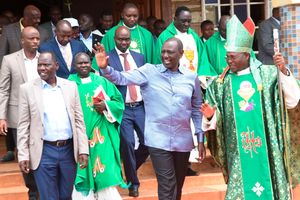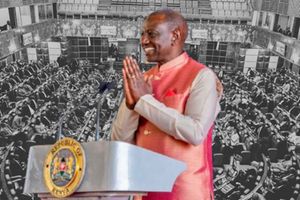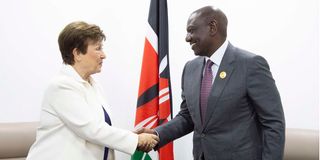
President William Ruto meets with IMF Managing Director Kristalina Georgieva on the sidelines of COP27 in Sharma El-Sheikh, Egypt on September 21, 2023.
As of December 31, 2024, President William Ruto had borrowed at least Sh1.4 trillion, departing from his campaign pledge to reduce loans as the main financier of government operations.
Dr Ruto, who was sworn in on September 13, 2022, has been in power for 31 months and has another 29 before his first five-year term comes to an end in August 2027.
The President’s insatiable appetite for borrowing loans has led to Kenya’s debt stock soaring. Reputable international credit rating agencies,Standard and Poor’s (S&P), Fitch Ratings and Moody’s have raised doubts on the country’s ability to manage the debt repayment.
Data from the Central Bank of Kenya (CBK), a State agency that regulates the banking industry in the country, shows that as at December 31, 2022 — three months after President Ruto took office — the country’s debt stock stood at Sh8.6 trillion.
The debt, which represented 67.8 per cent of the Gross Domestic Product (GDP), included Sh4.288 trillion in domestic borrowing and Sh4.29 trillion in foreign financing.
As at December 31, 2024, the 2025 Medium Term Debt Management Strategy, a government document published annually by the National Treasury and submitted to Parliament, shows that the country’s public debt stood at Sh10.6 trillion.
This represented 63 per cent of GDP against the benchmark debt threshold of 55 per cent of debt to GDP with the National Treasury having until November 1, 2028 to bring the present value of public debt to within the threshold.
The Sh10.6 trillion includes Sh5.2 trillion in domestic loans and Sh5.4 trillion in loans from the foreign markets.
Overburdened by public debt
The Sh1.4 trillion broken down means that as at December 31, 2024, when President Ruto was in his 27th month of rule, he was borrowing Sh74.1 billion a month, Sh2.5 billion a day, Sh102.9 million an hour and Sh1.7 million a second.
The borrowing spree goes against the President’s own pledge during the campaigns. He had said that he would focus on more investments and other revenue generation streams in a bid to reduce the public debt, which he admitted was choking the country’s economic growth.
“We will change this tradition of applying for loans and be all about investments and labour-intensive programmes as opposed to capital intensive projects,” President Ruto, then Deputy President, said on June 3, 2022 at a campaign rally in Nairobi’s Kamulu area.
This was ahead of the August 9, 2022 General Election.
He made the pledge cognizant of the fact that if he won the presidential race, he would be inheriting an economy that is overburdened by public debt.
Dr Ruto knew that the country was in an economic mess, due to the borrowing spree from China. There were also a myriad of mega corruption scandals by the Jubilee government under former President Uhuru Kenyatta, in which Dr Ruto was the DP.
“Borrowing money to run the government will not be an option for his government,” he said.
Dr Ruto accused his main rival in the August 9, 2022 presidential election — Azimio candidate Raila Odinga — of “planning to continue massive borrowing of loans.”
“Ours is about exploiting available local options to generate income to run the country,” he said, adding that over borrowing is not good as over 60 per cent of the country’s revenue goes into debt repayment.
“As of now, for every Sh10 that we collect in revenue, Sh6 goes into debt repayment,” the President said during a church service at Laare in Meru County on September 11, 2023, just two days before marking his first anniversary as President.
The country’s debt stock is bound to escalate with the government projecting a budget of Sh4.2 trillion in the 2025/26 financial year, currently under consideration in the National Assembly.
The budget has a fiscal deficit of Sh876.1 billion to be financed by a net external financing of Sh284.2 billion, about 1.5 percent of the GDP and a net domestic borrowing of Sh591.9 billion, which is 3.1 percent of the GDP.
The loans will likely be sourced from commercial markets with budget documents before Parliament showing zero funding from the International Monetary Fund (IMF) until June 2029.
While Kenya has been seeking IMF support to address fiscal deficits and economic challenges, the budget documents indicate a planned transition away from direct IMF financing, potentially with increased reliance on other lenders like the World Bank.
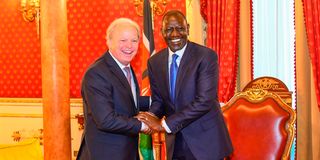
President William Ruto with World Bank Group Senior Managing Director for Development Policy and Partnerships Alex van Trotsenburg in January 29, 2024.
Auditor-General Nancy Gathungu has already warned that the Sh4.2 trillion budget for the 2025/26 financial year will expose the government to a borrowing spree, as it is not aligning with the anticipated revenue streams.
Ms Gathungu issued the warning as National Treasury Principal Secretary Dr Chris Kiptoo revealed that by March 2025, the government had overshot its domestic borrowing for the 2024/25 period by Sh220 billion against the limit approved by the National Assembly.
Unavoidable debt
The country’s public debt situation has also been captured by Trading Economics, a website that provides extensive economic data, indicators and news for various countries including Kenya and offers historical data, real-time updates and insights into economic trends used for research, investment and financial analysis.
The weakening of the Kenyan shilling against the major international currencies is not doing justice in the repayment of the dollar, Euro and yuan denominated external debts.
So, what changed?
National Treasury Cabinet Secretary John Mbadi did not respond to our inquiries sent to his known phone number.
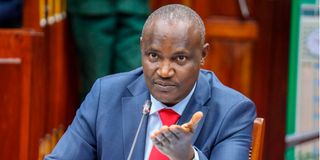
Treasury Cabinet Secretary John Mbadi
However, the National Assembly Budget and Appropriations Committee chairperson Samuel Atandi (Alego Usonga) noted that the economy is on the right track.
“Debt is unavoidable. We must borrow prudently going forward,” Mr Atandi said.
He accused former President Uhuru’s administration “of poor management of the economy, especially piling debt without channeling the same to development.”


